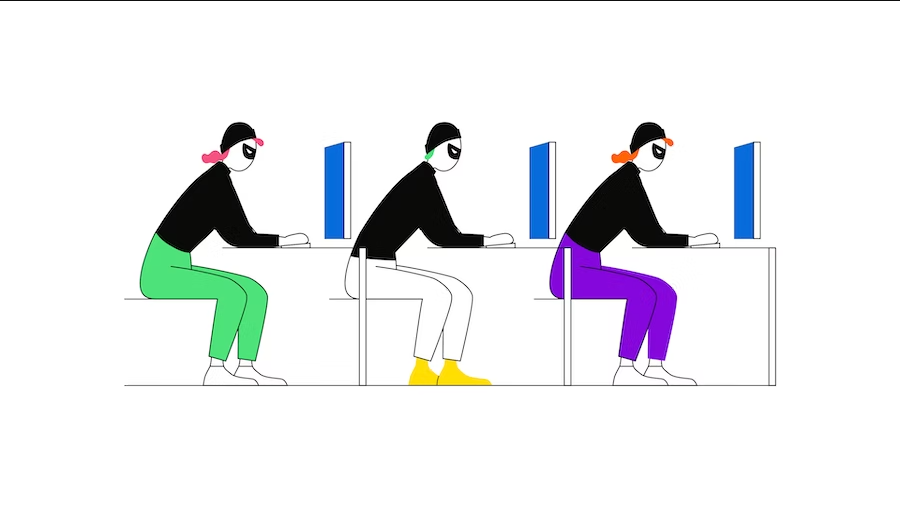What is a Bitcoin halving?
To fully understand Bitcoin halvings, it’s useful to take a step back and have a closer look at blocks in general. A block is a data structure that collates Bitcoin transaction records and verifies them through a proof-of-work (PoW) consensus mechanism. This means when a block is filled with data, miners attempt to solve the cryptographic puzzle to verify the Bitcoin transactions. If they solve the puzzle first, the completed block is added to the blockchain and the miner is given a reward. So, where does the halving come in?
A Bitcoin halving is a provision within Bitcoin’s code that reduces the Bitcoin block reward by half every 210,000 blocks, or roughly every 4 years. This process reduces the number of new coins entering the network, which encourages scarcity and avoids devaluation. This gradual reduction works to steadily reduce the introduction of new bitcoins as the total supply marches toward its fixed limit of 21 million bitcoins. Currently, around 90% of that total has been mined, and once the final Bitcoin has been mined (likely around the year 2140) no more can be created.
In the past, there have been three previous Bitcoin Halvings with the fourth halving expected to occur in April 2024 according to the Bitcoin halving countdown. The first Bitcoin block reward was 50 BTC. The current block reward is 6.25 BTC, but after the next halving the block reward will be 3.125 BTC.
What have we learned from previous Bitcoin halvings?

The 2012 halving
The first Bitcoin halving occurred on November 28, 2012, reducing the block reward from 50 to 25 BTC. In the following year, the Bitcoin price rose from around $12 to lofty highs of over $1,000 by December 2013. This was Bitcoin's first genuine bull run after the halving brought about scarcity to new coin creation. Also during this period, an estimated 30-40% of Bitcoin miners shut down operations as mining rewards fell below energy and hardware costs.
A key learning from the first halving is that it took over a year for the halving’s impact to manifest into substantially increased price developments. This could be because Bitcoin’s popularity was not at the levels we see today and there was little mainstream awareness or media attention around the halving because it had never occurred before.
The 2016 halving
The second Bitcoin halving took place on July 9, 2016. The mining reward was lowered from 25 to 12.5 BTC and the Bitcoin price rose from around $650 to over $2,500 by July 2017. However, a major Bitcoin price surge occurred in December 2017 when the price rocketed to nearly $20,000!
This also demonstrates a repeatable example of the 12-month timeline as the price acceleration mirrored the post-2012 halving event boom. It’s also important to note that there was a significantly larger spotlight on the 2016 halving not only because of the 2012 halving but wider cryptocurrency adoption and mainstream acceptance.
The 2020 halving
The third Bitcoin halving occurred on May 11, 2020, reducing the block reward from 12.5 to 6.25 BTC. In the subsequent months, the Bitcoin price consistently rose from around $8,500 to reach a (then) all-time high of around $65,000 by April 2021. Also, notable during this period, the Bitcoin supply sent to exchanges by miners was at a 12-month low as they looked to hold the coins in expectation of this price rise.
Interestingly, the significant price increase took only 10 months to materialise compared to the 12-month timeline of the two previous halvings. However, it’s also important to remember that the COVID-19 pandemic likely also played a major role in this rise. In 2020, the Bitcoin price surged by over 300% as government shutdowns and fears about the global economy led many investors to see Bitcoin as an alternative investment and store of value.
Potential Bitcoin price impacts

Previous Bitcoin Halving events have typically shown a positive impact on Bitcoin’s price and the upcoming 2024 halving could also have a significant impact on the wider cryptocurrency market. For example, during the 2012 halving the price of 1 BTC rose by 8,024% in the year following the halving. Furthermore, a year after the 2016 Bitcoin Halving, the market saw a 287% increase in the Bitcoin price. Also, a year after the 2020 halving, there was a 534% increase in the Bitcoin price.
With all this in mind, many are anticipating a price increase based on these past scenarios and the increased scarcity following the next halving. Nevertheless, it’s once again important to understand that we can only speculate on future price trends as there is no way to know for sure as past performance is not an indicator of future value developments. Also, it’s important to consider that the crypto market has matured since the last halving. Many different types of people hold Bitcoin now- from crypto newbies to experienced traders and institutional investors -so there may be different outcomes compared to previous market cycles. One thing is for sure though: the 2024 halving will have us all on the edge of our seats waiting to see how the market dynamics unfold and impact the Bitcoin price.
How can investors prepare for the next halving?
Unfortunately, there is no guaranteed path to investment success, but there are plenty of things you can do to get ready for the next halving and improve your chances. Here are some useful tips to help you on your journey:
Cost-averaging: Dollar-cost averaging is an investment strategy that focuses on investing fixed amounts of money on an asset in regular intervals (i.e. weekly, biweekly, monthly) over a long period. A cost-averaging strategy or Bitcoin savings plan leading up to halving may reduce exposure to volatility and short-term price fluctuations.
Seize the small wins: Taking partial profits on the potential upside price spikes before and after the halving can be a good way of protecting your profits long-term. Though ‘letting it run’ might offer more upside, taking a portion of the profit means you have some money at least.
Focus on miner activity: Keeping an eye on miner behaviour is useful as their activity impacts the wider market. There are several websites that provide mining calculations, mining rewards statistics, charts and hashrate distributions. Moreover, you can go the direct route and visit the websites of the mining companies themselves for updates and highlights. There are some experts believe the Bitcoin hashrate (computing power) could drop by as much as 30% as unprofitable miners may shut down after the 2024 halving event. Therefore, if a large amount of miners shut down their operations, or sell portions of their Bitcoin holdings, this can heavily impact the market and future supply.
Hodl, maybe?: Previous halvings have shown keeping a larger portion of holdings long-term might be prudent if significant price increases repeat themselves. Perhaps patience is a virtue…
Diversification: You’ve probably heard it a lot over the years and with good reason. Diversifying across other crypto assets rather than just focusing solely on Bitcoin can help to spread the risk and lead to a more consistent overall return. For example, Chainlink (LINK) saw huge gains of over 925% in the 12 months after Bitcoin’s 2020 halving as their real-world utility saw them benefit from improved investor optimism and improved market sentiment post-halving.
Education is your friend: Knowledge is power. Learn more about Bitcoin and previous Bitcoin halving events to give yourself the best chance of success.
The fun has just begun…
To celebrate this momentous occasion, we are giving away €50,000 in Bitcoin, FC Bayern Munich match tickets and other amazing prizes!
Follow our Bitcoin halving countdown for the latest Bitcoin news, competitions, announcements, and price developments.
We deep dive into all things Bitcoin with in-depth market analysis, crypto commentary and expert insights coming your way in the upcoming months that will help you prepare for the halving.
So stay tuned and be part of crypto history with Bitpanda!
Disclaimer
This article does not constitute investment advice, nor is it an offer or invitation to purchase any digital assets. This article is for general purposes of information only and no representation or warranty, either expressed or implied, is made as to, and no reliance should be placed on, the fairness, accuracy, completeness or correctness of this article or opinions contained herein. Investing carries risks. Make sure to conduct your own research before making any investment.
 Commodities* Invest in commodities 24/7
Commodities* Invest in commodities 24/7 BITCOIN What to know when you are just starting to invest
BITCOIN What to know when you are just starting to invest ASSET MANAGEMENT Your investment, your assets: Why your money is safe with Bitpanda
ASSET MANAGEMENT Your investment, your assets: Why your money is safe with Bitpanda COUNTDOWNBitcoin Halving Countdown 2024
COUNTDOWNBitcoin Halving Countdown 2024 ACADEMYWhat is the Bitcoin halving?
ACADEMYWhat is the Bitcoin halving?








